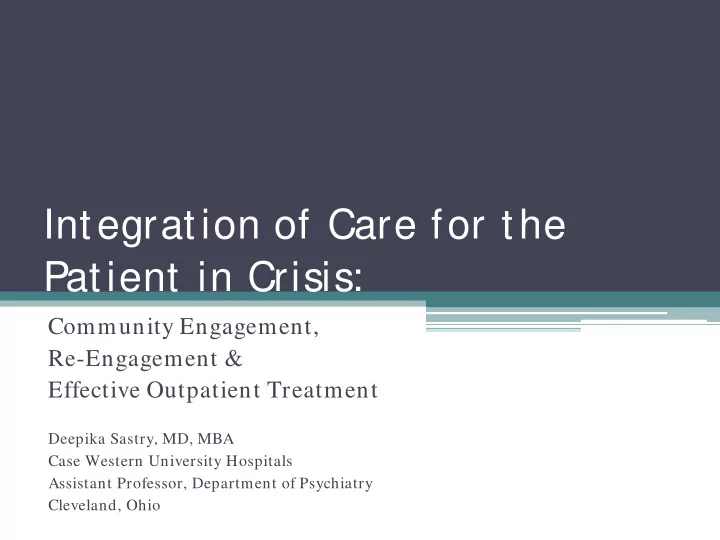

Integration of Care for the Patient in Crisis: Community Engagement, Re-Engagement & Effective Outpatient Treatment Deepika Sastry, MD, MBA Case Western University Hospitals Assistant Professor, Department of Psychiatry Cleveland, Ohio
The Problem • SMI patients have HIGH rates of Tx Discontinuation ▫ 30-45% don’t attend initial appointments ▫ < 50% receive continuous care for 12 months Result? Symptom relapse, inpatient re-admission, homelessness, substance use, incarceration, unemployment TE Smith, et al: Determining engagement in services for high-need individuals with serious mental illness. Psychiatric Services , 2014 November 1; 65(11): 1378-80.
Origins • Community Mental Health Centers Act (1963) ▫ CMHC in every community ▫ Decrease in Inpatient beds across U.S. 400,000 in 1970 now less than 50,000 • Managed Behavioral Health Care (1980s, 90s) ▫ Budget cuts/ Low reimbursement for MH services ▫ Limited medication coverage Result? Reliance on ER “Safety Net” Alakeson V, Pande N, and Ludwig M: A plan to reduce emergency room ‘boarding’ of psychiatric patients. Health Affairs 29, no. 9 (2010): 1637-42
Policy Overview • Mental Health Parity and Addiction Equity Act (1996, 2008) ▫ Equal financial requirements & treatment coverage for MH and Medical/ Surgical benefits ▫ “Carve out” MH benefits • Affordable Care Act (ACA, 2010) ▫ Expanded mental health and substance use disorder benefits & federal parity protections ▫ Additional 62 million Americans insured
Policy Overview • ACA, Section 2703 ▫ Medicaid Health Home State Plan Option www.Medicaid.gov: “ Health Homes providers will integrate and coordinate all primary, acute, behavioral health, and long-term services and supports to treat the whole person .” Chronic conditions (including MH and Substance Abuse) State-designed, Federally funded Alakeson V, Pande N, and Ludwig M: A plan to reduce emergency room ‘boarding’ of psychiatric patients. Health Affairs 29, no. 9 (2010): 1637-42
Economics 101 • (Mental) Healthcare DELIVERY Problem ▫ Supply Chain issue Starting in ER long wait for an inpatient bed ▫ Complex System Variability in state, hospital, and insurance regulations ER vs CMHCs: different Funding, Governance, Licensing • SUPPLY & DEMAND ▫ Shrinking psychiatric resources ▫ Expanding patient population American College of Emergency Physicians: Care of the Psychiatric Patient in the Emergency Department, A review of the literature. October 2014
Community Engagement Shared Responsibility of SMI Patients Patient Engagem ent Team -based Com m unity Treatm ent Partnerships
S hared Responsibility • Collaboration between ERs and CMHCs ▫ Joint ownership of SMI patient needs CMH Liaison to ER CMH staff on-call or in ER for treatment/ disposition needs ER communication with CMH (linked EHR?) Timely follow up after discharge from ER/ Inpatient unit • Barriers ▫ Separate funding/ licensing/ governance ▫ No precedent Alakeson V, Pande N, and Ludwig M: A plan to reduce emergency room ‘boarding’ of psychiatric patients. Health Affairs 29, no. 9 (2010): 1637-42
Team-Based Treatment • Psychiatry • Social Work • Nursing • Case Manager • Peer Support • Patient advocates (family, community, NAMI) • Primary Care CMH Emergency Room
Community Partnerships • Law Enforcement ▫ Crisis Intervention Team (CIT) ▫ Co-responder model • Mental Health Advocacy Groups • Corporations/ Non-profit groups • Regional and state government • Academic medical centers • Private hospitals Alakeson V, Pande N, and Ludwig M: A plan to reduce emergency room ‘boarding’ of psychiatric patients. Health Affairs 29, no. 9 (2010): 1637-42
Comprehensive Community Mental Health Services Center for Health Care Services (San Antonio, TX) Community Partners, Inc. (Tuscon, AZ)
One size does NOT fit all • Nearly 50% of patients with SMI did not receive MH treatment in prior year • How to engage? Or re-engage? ▫ RECOVERY: “a process of change through which individuals improve their health and wellness, live self-directed lives, and strive to reach their full potential.” Dixon L, et al: Treatment engagement of individuals experiencing mental illness: review and update. World Psychiatry. February 2016, 15: 13-20.
4 DIMENSIONS HEALTH HOME PURPOSE COMMUNITY
Recovery-Oriented Treatment • Strong therapeutic alliance • Person-centered ▫ Housing, Finances, Employment • Shared decision making • Patient empowerment & Autonomy
Engagement S trategies • Assertive Community Treatment (ACT) ▫ Homeless SMI population ▫ Multidisciplinary team • Integrated Care ▫ Evidence-based best practice ▫ MH services embedded in Primary Care • Telepsychiatry ▫ Improved access ▫ Low cost ▫ Concerns: Privacy, Patient safety, reimbursement? Unutzer J et al: The Collaborative Care Model: an approach for integrating physical and mental health care in Medicaid health homes. Health Hom e Inform ation Resource Center, Center for Health Care Strategies, Inc. May 2013
Disruptive Innovations • Technology ▫ Mobile phone check-ins ▫ Online outreach (the new ACT?) ▫ Consolidating EHRs • Peer-based services ▫ Medicaid reimburses ▫ WRAP (Wellness Action Recovery Plan) • Culturally competent Care ▫ DSM-5 Cultural Formulation Interview (CFI) Dixon L, et al: Treatment engagement of individuals experiencing mental illness: review and update. World Psychiatry. February 2016, 15: 13-20.
In Conclusion • Triple Aim for Mental Health Treatment ▫ Cost-effective care ▫ Improved quality of care ▫ Caring for the whole person
Recommend
More recommend